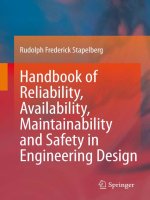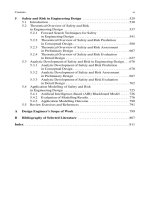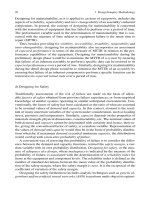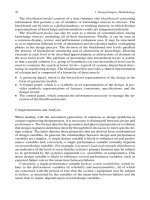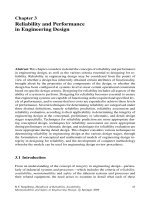Handbook of Reliability, Availability, Maintainability and Safety in Engineering Design - Part 54 potx
Bạn đang xem bản rút gọn của tài liệu. Xem và tải ngay bản đầy đủ của tài liệu tại đây (421.13 KB, 10 trang )
4.4 Application Modelling of Availability and Maintainability in Engineering Design 513
Table 4.18 Comparative analysis of preliminary design data and simulation output data for simu-
lation model sector 2
Assembly Design flow Model flow Model min. Model max.
vol. vol. flow vol. flow vol.
Rod mill 1 307 315 285 345
Rod mill 2 307 315 285 345
Rod mill 3 307 315 285 345
Rod mill 4 307 315 285 345
Mill discharge tank 1 1,119 1,120 1,110 1,130
Mill discharge tank 2 1,119 1,120 1,110 1,130
Mill discharge tank 3 1,119 1,120 1,110 1,130
Mill discharge tank 4
Classifier feed pump 1/1 560 560 540 580
Classifier feed pump 1/2 560 560 540 580
Classifier feed pump 2/1 560 560 540 580
Classifier feed pump 2/2 560 560 540 580
Classifier feed pump 3/1 560 560 540 580
Classifier feed pump 3/2 560 560 540 580
Classifier feed pump (S)
Screen feed pot 1 1,152 1,154 1,148 1,160
Screen feed pot 2 1,152 1,154 1,148 1,160
Screen feed pot 3 1,152 1,154 1,148 1,160
Screen feed pot 4
Ball mill 1 515 520 580 540
Ball mill 2 515 520 580 540
Ball mill 3 515 520 580 540
Ball mill 4 515 520 580 540
e) Evaluation of Simulation Model Sector 3
A major characteristic oftheprocess flowdiagram (PFD) of sector 3 is that it depicts
continuous fluid flow and indicates how inputs are transformed by each assembly
into outputs that, in turn, become modified logical flow inputs to the next assembly,
as depicted in the preliminary design data given in Table 4.20. The PFD is sys-
tematically examined to analyse deviations in process flow and system performance
and, in this case, to determine mass fluid flow balance through integrated assem-
blies. Each assembly is graphically represented in the sim ulation model by a virtual
prototype process equipment model (PEM).
Each of the assemblies of the PFD depicted in Fig. 4.60, consisting of four pro-
cessing tank systems containing 23 assemblies (four double tank feeder chutes, four
processing tanks plus one standby, four sets of three-up parallel pumps, and one
pump/condensate assembly), is a process equipment model.
A fluid mass-flow balance is the application of conservation of m ass to the anal-
ysis of physical systems. By accounting for materials (solids or fluids) entering and
leaving a system, mass flows can be identified from one system, o r assembly, to the
next. The exact mass-balance theory u sed in the analysis of the system depends on
514 4 Availability and Maintainability in Engineering Design
Fig. 4.59 Simulation output for simulation model sector 2
the context of the design problem, specifically where the theory is used to analyse
alternative processes.
Process design specifications Each PEM contains selected model components that
are configured in such a way that the design specifications of each assembly are
met through the component’s attributes. The model component’s attributes for the
four double tank feeder chutes convert the chutes’ output by modifying the compo-
nent’sinputs through a selection of statistical functions based on feed specifications.
The model component’s attributes for each of the processing tanks’ pumps convert
a pump’s output by modifying the inputs through a selection of statistical functions
representing the appropriate pump delivery characteristics.
Figure 4.6 1 illustrates the application of Petri net (PN)-based o ptimisation algo-
rithms in dynamic systems simulation. The optimisation algorithm is a model com-
ponent inherent to the processing tank PEM and determines process flow pressure
surge through the tank.
Output performance results The fluid mass that enters a system must, by conser-
vation of mass, either leave the system or accumulate within the system. Basically,
the fluid mass-flow balance equation for a system without internal chemical reac-
tions is: input = output + accumulation. In the absence of a chemical reaction,
4.4 Application Modelling of Availability and Maintainability in Engineering Design 515
Table 4.19 Acceptance criteria of simulation output data, with preliminary design data for simu-
lation model sector 2
Assembly Design min. Design max. Model min. Model max. Yes/no
vol. 2.5% tol. vol. 2.5% tol. vol. vol. at 99%
Rod mill 1 300 315 285 345 No
Rod mill 2 300 315 285 345 No
Rod mill 3 300 315 285 345 No
Rod mill 4 300 315 285 345 No
Mill discharge tank 1 1,080 1,148 1,110 1,130 Yes
Mill discharge tank 2 1,080 1,148 1,110 1,130 Yes
Mill discharge tank 3 1,080 1,148 1,110 1,130 Yes
Mill discharge tank 4
Classifier feed pump 1/1 545 575 540 580 No
Classifier feed pump 1/2 545 575 540 580 No
Classifier feed pump 2/1 545 575 540 580 No
Classifier feed pump 2/2 545 575 540 580 No
Classifier feed pump 3/1 545 575 540 580 No
Classifier feed pump 3/2 545 575 540 580 No
Classifier feed pump (S)
Screen feed pot 1 1,122 1,182 1,148 1,160 Yes
Screen feed pot 2 1,122 1,182 1,148 1,160 Yes
Screen feed pot 3 1,122 1,182 1,148 1,160 Yes
Screen feed pot 4
Ball mill 1 502 528 510 530 Part
Ball mill 2 502 528 510 530 Part
Ball mill 3 502 528 510 530 Part
Ball mill 4 502 528 510 530 Part
the logical fluid flow in and out of a system or assembly will be the same. To per-
form a balance, the boundaries of the system must be well defined. Fluid mass-flow
balances can be taken over physical systems at m ultiple scales, taking into consider-
ation flow surges, and can be simplified with the assumption of steady state, where
the accumulation term is zero.
Figure 4.6 2 illustr ates a typical output document showing performance results of
the processing tank PEM. These performance variables relate to assembly contents,
input and output flow quantities, as well as flow surges. The flow surge gives an
indication of deviations from steady-state flow. The plotted graph shows the trend
of flow from start-up to steady state.
f) Conclusion of Simulation Model Sector 3 Evaluation
Table 4.21 g ives the values of a comparative analysis of preliminary design data and
simulation output data for simulation model sector 3.
Figure 4.63 shows the simulation model’s output for simulation model sector 3.
As with simulation model sectors 1 and 2, the range or variance of the model’s
516 4 Availability and Maintainability in Engineering Design
Table 4.20 Preliminary design data for simulation model sector 3
Assembly Code Flow vol. Mass flow Liq. Solids
Desilicator 1 T026021 1,250 2,136 1,213 937
Desilicator 2 T026031 968 1,642 928 721
Desilicator 3 T026041 968 1,642 928 721
Desilicator 4 T026051 1,250 2,136 1,213 937
Desilicator 5 T026061 968 1,642 928 721
Slurry splitter box 1 L026031 1,250 2,136 1,197 938
Slurry splitter box 2 L026041 968 1,642 928 721
Slurry splitter box 3 L026051 968 1,642 928 721
Slurry splitter box 4 L026061 1,250 2,136 1,197 938
Slurry forwarding pump 1 P026011 1,250 2,136 1,197 938
Slurry forwarding pump 2 P026021 968 1,642 928 721
Slurry forwarding pump 3 P026031 968 1,642 928 721
Slurry forwarding pump 4 P026041 968 1,642 928 721
Slurry forwarding pump 5 P026051 968 1,642 928 721
Slurry forwarding pump 6 P026061 1,250 2,136 1,197 938
Discharge pump 1 P026071 323 547 312 235
Discharge pump 2 P026171 323 547 312 235
Discharge pump 3 P026271 323 547 312 235
Discharge pump 4 P026301 323 547 312 235
Discharge pump 5 P026302 323 547 312 235
Discharge pump 6 P026303 323 547 312 235
Table 4.21 Comparative analysis of preliminary design data and simulation output data for simu-
lation model sector 3
Assembly Design flow Model flow Model min. Model max.
vol. vol. flow vol. flow vol.
Desilicator 1 1,250 1,255 1,245 1,265
Desilicator 2 968 967.5 960 975
Desilicator 3 968 967.5 960 975
Desilicator 4 1,250 1,255 1,245 1,265
Desilicator 5 968 967.5 960 975
Slurry splitter box 1 1,250 1,250 1,245 1,255
Slurry splitter box 2 968 967.5 960 975
Slurry splitter box 3 968 967.5 960 975
Slurry splitter box 4 1,250 1,250 1,245 1,255
Slurry forwarding pump 1 1,250 1,250 1,240 1,260
Slurry forwarding pump 2 968 967.5 955 980
Slurry forwarding pump 3 968 967.5 955 980
Slurry forwarding pump 4 968 967.5 955 980
Slurry forwarding pump 5 968 967.5 955 980
Slurry forwarding pump 6 1,250 1,250 1,240 1,260
Discharge pump 1 323 325 320 330
Discharge pump 2 323 325 320 330
Discharge pump 3 323 325 320 330
Discharge pump 4 323 325 320 330
Discharge pump 5 323 325 320 330
Discharge pump 6 323 325 320 330
4.4 Application Modelling of Availability and Maintainability in Engineering Design 517
Fig. 4.60 Process flow diagram for simulation model sector 3
output data is compared to acceptable lower and upper confidence limits within
a specified exact probability. The design specification is again used as the mean,
and the allowable design tolerance of ±2.5% of the mean is used as the square
root of the variance, namely the standard deviation, in the t-distribution, to deter-
mine a confidence range or interval with lower tolerance limit (LL) and an upper
tolerance limit (UL) at a 99% level of confidence for ten simulation runs. The mini-
mum and maximum values of the simulation model’s output data are similarly com-
pared against this confidence range or interval. The last column of Table 4.22 indi-
cates whether the model’s output is acceptable in meeting the design criteria within
a 99% level of confidence. As can be seen, all the assemblies h ave a flow volume
variance that is acceptable within the 99% confidence interval as set by the design
criteria.
518 4 Availability and Maintainability in Engineering Design
Fig. 4.61 Design details for simulation model sector 3: process design specifications
4.4.3 Application M odelling Outcome
Verification of the process simulation modelwith the PEM blocks included the spec-
ification of model components as well as the formulation of functional relationships,
all of which are inherent in the dynamic systems simulation blackboard model that
is used to control the design knowledge sources and integrate the knowledge-based
design applications. In contrast to model verification, the validity of the simulation
model depended on the ability of the model to predict the results of the model’s
behaviour. However, validation of the simulation model was not basedonacorre-
lation of the mean values of the model’s output data and the specified design flow
volumes for each PEM, due to possible problems of autocorrelation and the lim-
ited number of simulation model runs not being large enough to justify statistical
spectral analysis of the output data. Rather, statistical inference was applied to de-
termine whether the range of the m odel’s output data fell between acceptable lower
and upper confidence limits within a specified exact probability.
In order to determine a confidence range or interval with a lower tolerance limit
(LL) and an upper tolerance limit (UL), the specified d esign flow volume was used
as the mean, and the allowable design tolerance of ±2.5% of the mean was used as
4.4 Application Modelling of Availability and Maintainability in Engineering Design 519
Fig. 4.62 Design details for simulation model sector 3: output performance results
standard deviation in the statistical t-distribution at a 99% level of confidence for ten
simulation runs. The minimum and maximum values of the simulation model’s out-
put data were then compared against this confidence range or interval to determine
whether the model’s output was acceptable in meeting the design criteria.
As indicated in Tables 4.16, 4.19 and 4 .22, not all of the assemblies listed met the
required design criteria, indicating that the simulation model failed at a 99% level
of confidence specifically for those assemblies. However, the statistical approach of
determining confidence intervals with the t-distribution was repeated for 95% and
90% levels of confidence. Close on 85% of the simulation model’s output data was
found to meet the required design criteria at a 95% level of confidence, and all of
the simulation model’s output data met the required design criteria at a 95% level
of confidence. This implies that the process simulation model with the PEM blocks
is capable of predicting process output within a 10% margin of error for each PEM.
Due to the fact that the model simulates a complex integrated continuous process
flow, a 90% level of confidence is acceptable for the preliminary design phase of the
engineered installation.
520 4 Availability and Maintainability in Engineering Design
Fig. 4.63 Simulation output for simulation model sector 3
4.5 Review Exercises and References
Review Exercises
1. Discuss cost modelling for design availability and main tainability.
2. Explain economic loss and the cost of dependency.
3. Give a brief account of life-cycle analysis and life-cycle costs.
4. Consider life-cycle cost elements in engineering design.
5. Describe present value calculations for life-cycle costs.
6. Discuss trade-off measurement for life-cycle costs.
7. Give a brief account of availability modelling based on system performance,
considering process capability, process char acteristics and functional effective-
ness.
8. Explain the concept of sizing maximum or design capacity.
9. Define inherent availability (A
i
)
10. Discuss inherent availability modelling with uncertainty.
11. Discuss the significance of the application of the exponential function for deter-
mining inhere nt availability.
12. Describe confidence determination of inherent availability pred ictions.
4.5 Review Exercises and References 521
Table 4.22 Acceptance criteria of simulation output data, with preliminary design data for simu-
lation model sector 3
Assembly Design min. Design max. Model min. M odel max. Yes/no
vol. 2.5% tol. vol. 2.5% tol. vol. vol. at 99%
Desilicator 1 1,220 1,280 1,245 1,265 Yes
Desilicator 2 943 993 960 975 Yes
Desilicator 3 943 993 960 975 Yes
Desilicator 4 1,220 1,280 1,245 1,265 Yes
Desilicator 5 943 993 960 975 Yes
Slurry splitter box 1 1,220 1,280 1,245 1,255 Yes
Slurry splitter box 2 943 993 960 975 Yes
Slurry splitter box 3 943 993 960 975 Yes
Slurry splitter box 4 1,220 1,280 1,245 1,255 Yes
Slurry forward pump 1 1,220 1,280 1,240 1,260 Yes
Slurry forward pump 2 943 993 955 980 Yes
Slurry forward pump 3 943 993 955 980 Yes
Slurry forward pump 4 943 993 955 980 Yes
Slurry forward pump 5 943 993 955 980 Yes
Slurry forward pump 6 1,220 1,280 1,240 1,260 Yes
Discharge pump 1 315 330 320 330 Yes
Discharge pump 2 315 330 320 330 Yes
Discharge pump 3 315 330 320 330 Yes
Discharge pump 4 315 330 320 330 Yes
Discharge pump 5 315 330 320 330 Yes
Discharge pump 6 315 330 320 330 Yes
13. Discuss preliminary maintainability modelling.
14. Give a brief account of Markov modelling for design availability and maintain-
ability with regard to the two-state Markov model, and the multi-state Markov
model.
15. Define Markov model supplementary variables.
16. Define achieved availability.
17. Discuss achieved availability modelling subject to maintenance.
18. Consider maintainability assessment with maintenance modelling.
19. Discuss the impact of maintenance assessment on systems design.
20. Describe maintainability measures and maintenance assessment.
21. Discuss maintenance strategies and cost optimisation modelling.
22. Give a brief account of the basic principles of maintenance.
23. Describe a model of preventive maintenance physical checks.
24. Describe a model of preventive maintenance replacement shuts.
25. Define m aintenance strategy.
26. Explain the concepts of reliability, availability and maintainability in mainte-
nance strategy and discuss their differences.
27. Give a brief account of the three principles of a maintenance strategy.
28. Discuss establishing maintenance strategies for engineering design.
29. Describe maintenance cost optimisation modelling.
30. Define dependability modelling.
522 4 Availability and Maintainability in Engineering Design
31. Discuss the significance of dependability modelling for design availability and
maintainability.
32. Define operational availability (A
o
).
33. Discuss operational availability modelling with logistic support.
34. Consider a general approach for evaluating operational availability.
35. Give a brief account of system availability evaluation considerations.
36. Discuss maintainability evaluation and built-in or non-destructive testing (BIT).
37. Describe maintainability evaluation indices.
38. Give a brief account of diagnostic systems and built-in testing.
39. Explain basic system and BIT concurrent design and evaluation.
40. Discuss the evaluation of BIT systems.
41. Consider application modelling of availability and maintainability in en gineer-
ing design.
42. Define equivalent availability (EA).
43. Discuss and compare the equivalent ma intainability measures of downtime and
outage.
44. Describe outage measurement with the ratio of ER over EM.
45. Discuss system p erformance measur es and limits of capability.
46. Describe performance parameters for system integrity and their significance in
engineering design.
47. Discuss analysis of the parameter profile matrix.
48. Discuss the significance of the design checklist.
49. Explain integrity prediction of common items of equipment.
50. Give a brief account of a design review of p erformance parameters for system
integrity.
51. Discuss the significance o f reliability and maintainability checklists.
52. Describe system performance analysis and simulation modelling in engineering
design.
53. Consider different types of system performance models.
54. Briefly describe the significance and contribution of system simulation mod-
elling in engineering design.
55. Discuss uncertainty in system performance simulation modelling.
56. Explain propagation of the effect of uncertainties.
57. Describe the extreme condition approach f or uncertainty analysis.
58. Describe the statistical approach f or un certainty analysis.
59. Give an explanation for mitigating the effect of u ncertainty.
60. Describe maximising design availability using Petri net models.
61. Discuss Petri net theory and its application in engineering design.
62. Define the basic Petri net model and compare it to the definitions of stochastic
Petri nets as well as Markovian stochastic Petri nets.
63. Briefly explain the process of generating reachability graphs.
64. Discuss the measures of Markovian stochastic Petri nets.
65. Define stochastic reward nets and non-Markovian stochastic Petri nets.
66. Consider designing for availability using Petri net modelling.
67. Describe numerical computations for the availability Petr i net model.

